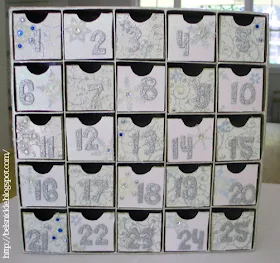 |
| Burn a candle to celebrate Advent. |
Today, most Advent calendars are made for children. Many take the form
of a large rectangular card with "windows" of which there are often 24;
one for each day of December leading up to Christmas Day. One is opened
every day during Advent. In many of these calendars, each window opens
to reveal an image, a poem, or a portion of a story such as the story of
the Nativity of Jesus. More elaborate Advent calendars have a small
gift concealed in each window, such as a toy or a chocolate item.
The origins of the Advent calendar come from German Lutherans who, at
least as early as the beginning of the 19th century, would count down
the first 24 days of December physically. Often this meant simply
drawing a chalk line on the door each day, beginning on December 1. Some
families had more elaborate means of marking the days, such as lighting
a new candle (perhaps the genesis of today's Advent wreath) or hanging a
little religious picture on the wall each day.
 |
| A simple, silver and white Advent calendar made with cardboard drawers. |
The first known Advent calendar was handmade in 1851. According to the
Lower Austrian (NÖ) Landesmuseum, the first printed Advent calendar was
produced in Hamburg in 1902 or 1903. Other authorities state that a
Swabian parishioner, Gerhard Lang, was responsible for the first printed
calendar, in 1908.
Lang was certainly the progenitor of today's calendar. He was a
printer in the firm Reichhold & Lang of Munich who, in 1908, made 24
little colored pictures that could be affixed to a piece of cardboard.
Several years later, he introduced a calendar with 24 little doors. He
created and marketed at least 30 designs before his firm went out of
business in the 1930s. In this same time period, Sankt Johannis Printing
Company started producing religious Advent calendars, with Bible verses
instead of pictures behind the doors.
The practice disappeared during World War II, apparently to save paper.
After the war, Richard Sellmer of Stuttgart resurrected the commercial
Advent calendar and is responsible for its widespread popularity. His
company, Richard Sellmer Verlag, today maintains a stock of over
1,000,000 calendars worldwide. Other companies such as Cadbury's who
specialize in the making of calendars have similar stocks, if not
higher.
Advent Calendars Kids Can Help Create:

How much did the cardboard Advent calender cost you and where did you buy it?
ReplyDeleteI believe I purchased that cardboard Advent calendar at a Hobby Lobby store. It was around $20.
ReplyDelete